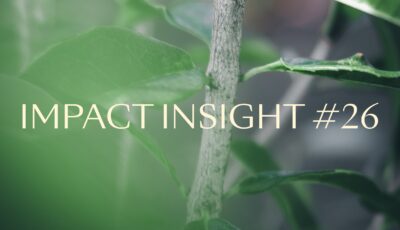Impact Insights #4

With so much happening in the world of impact and sustainability, it can be challenging to stay on top of the latest trends and developments. That's why our impact team has put together Impact Insights. A monthly series to help you stay informed and ahead of the curve. So sit back, relax, and get ready to expand your knowledge on the latest impact and sustainability news from April.
Curated by Norselab's former Sustainability Specialist, Kenza Akallal
■The future will be shaped by decisions we make today.
The UN Intergovernmental Panel on Climate Change (IPCC) has published the synthesis of the world’s most comprehensive assessment of climate change, detailing the “unequivocal” role of humans, its impacts on “every region” of the world and what can be and must be done to solve it. The report underscores that it is “more likely than not” in the near-term to reach a 1.5C rise since pre-industrial times and every fraction of additional temperature changes will further intensify the severity of impacts.
Climate change taking place now will continue across the lifespan of three generations born from the 1950s, 1970s and 2020s. “In short, our world needs climate action on all fronts,” said UN Secretary General António Guterres. “The choices and actions implemented in this decade will have impacts now and for thousands of years.” The solutions are here and affordable, from investing in clean energy and efficiency, shifting to electric vehicles to decarbonizing aviation and shipping. To navigate the reports, you can also ask ChatGPT ChatIPCC questions on climate change and expect answers drawn from scientific literature assessed by IPCC.
■Regulatory round-up. Recent weeks have seen a number of developments in the sustainable finance regulatory space.
The European Commission has published the long-awaited draft for the outstanding environmental objectives of the EU Taxonomy: water and marine life, pollution prevention, circular economy and biodiversity and ecosystems. These drafts are currently open for feedback and planned for adoption in Q2. Missing technical criteria for forestry, agriculture and fishing sectors did not go unnoticed, pending “further assessment and calibration”. Earlier this year, a coalition of environmental NGOs urged the European Commission to consider “no Delegated Act than a greenwashed one” on these sectors. There has also been recent criticism of the taxonomy favoring new green builds over incentivising retrofitting existing real estate.
The European Commission has also provided clarifications on SFDR interpretations, confirming that SFDR will remain a disclosure regime with no minimum standards for “sustainable investments” leaving the responsibility to define “sustainable investments” to investors.
The European Parliament approved a landmark deforestation law to prevent the sale of products produced on deforested land. Under the legislation passed this month, companies need to prove that they did not produce key products impacting deforestation on land that has been deforested after 2020, or risk hefty fines. The EU says it has put a number of safeguards in place to ensure that the due diligence resulting from the law is manageable for companies, and particularly for smallholder farmers.
■Protecting biodiversity is lower than the cost of inaction.
Financing earmarked to protect and restore the planet’s natural resources currently amounts to over USD 160 billion per year. This is however less than one-sixth of the annual investment in the energy transition, and the financing will need to reach almost USD 1 trillion by 2030 to sustainably manage biodiversity and maintain the integrity of ecosystems.
Safeguarding biodiversity won’t be cheap, but it is far less expensive than the alternative. Annual losses from deteriorating biodiversity could amount to over USD 10 trillion per year by conservative estimates. Meanwhile, governments have promised to plant 633 million hectares of trees to help save the planet. This equates to an area bigger than the Amazon rainforest.
Companies across sectors are also pledging to the WEF initiative to conserve, restore and grow 1 trillion trees by 2030. The goal is laudable but is it remotely plausible? Check out FT’s big take on the question.
■Clean energy is progressing faster than you think.
The energy world is changing fast and clean technologies are gaining momentum. The International Energy Agency’s latest data indicates that, for the first time, the peak in fossil fuel demand is on track to happen before the end of the 2020s.
■Carbon capture, utilization and storage.
The science is clear. Climate mitigation plans must reduce emissions across company operations and value chains first, but can also invest in natural and engineered carbon capture in parallel where no mitigation is possible. Recent research reported that the number of carbon capture, utilization and storage hubs under development has more than tripled since 2021.
More than 140 new projects were announced in 2022, increasing planned storage capacity by 80 percent, and capture capacity by 30 percent. This signals an increasing confidence in the industry, driven in part by policy incentives in the United States, Canada and the United Kingdom, strengthened climate pledges and rising carbon prices.
In related news, Remove launched the latest evolution of Europe’s “first and only” accelerator program designed to support early-stage carbon dioxide removal startups, and it is accepting applications for its newest cohort.
■Circular plastic roadmap.
Packaging represents 35% of plastics consumed annually in Norway and over 50 kg of plastic waste per person per year. But what happens to packaging once products are consumed? Nearly 80% is incinerated or sent to landfill after only a short use period. Systemiq's recent report series shows how the system can reach 69% circularity through a combination of reduction, reuse, substitution, as well as mechanical and chemical recycling. While the study focuses on Norway, its findings are representative of the plastics systems of most developed, high-consumption countries in Europe and beyond.
Sign up to our newsletter to get the next Norselab Impact Insights straight into your inbox.


